When you imagine a beautiful day on the water, what comes to mind? Waterskiing on a tranquil lake? Working a quiet shoreline casting your favorite lure? Do your thoughts stray to a back bay sandbar, rafting up with friends? Or maybe it’s breaking the inlet at sunrise for a day of ocean fishing?
Boating means different things to different people, but tens of thousands of boat owners live and boat in congested waterways that require a heightened level of awareness. If you boat in one of our country’s metropolitan regions, many of which are also busy commercial ports, you are navigating in an environment where you will be in close contact with vessels that operate under a different set of rules. In some ports, you will even find yourself in the company of ships so big they make your boat look like a barnacle on the back of a whale.
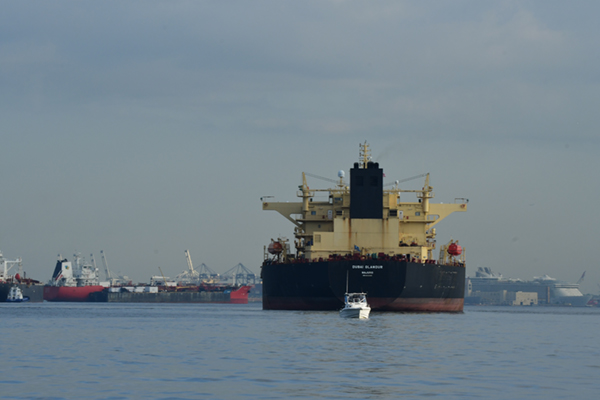
One Yamaha owner told us that after three decades of fishing out of an inlet where commercial vessel traffic was almost nonexistent, he moved to a new locale adjacent to New York Harbor and Port Newark. His former berth at a marina located on a small tidal river had easy access to the ocean through an inlet that was only challenging under severe weather conditions. Its inlet and river host a fair amount of recreational boat traffic and the occasional commercial fishing trawler or clammer headed to the unloading dock at a modest commercial fishing center adjacent to the inlet.
The move placed him in one of the busiest commercial ports in the world where scores of massive tankers, freighters, and container ships, some as large as the nearby skyscrapers, plied the waterways on a daily basis. Ferries, some that plod along throwing massive wakes and others that rush to their destinations at 30-plus knots, feed a daily stream of commuters to and from the city. There is a veritable flotilla of tour and dinner cruise boats navigating the waters around the sprawling harbor complex in addition to tugboats, barges and workboats, some that literally defy description. This parade of commercial vessels goes on day in and day out, and mixed in with it are recreational boats both large and small. It didn’t take long to realize that he, like Dorothy in Oz, wasn’t in Kansas anymore. This was big time boating in an environment rife with potential dangers that he never encountered before. Similar navigational challenges can be found in metropolitan harbors with commercial ports around the nation, places like Norfolk, Virginia, Miami and Jacksonville, Florida, New Orleans, Louisiana, Houston, Texas, Los Angeles, California and even Chicago, Illinois, one of many busy ports on the Great Lakes.
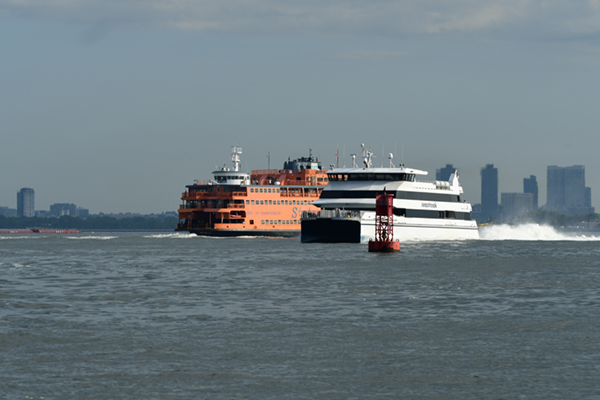
For some wisdom on boating and fishing in and around a major port we spoke with Yamaha pro captain Frank Crescitelli who grew up on Staten Island on the banks of New York Harbor and Raritan Bay. Frank has run boats in these congested waters for almost 50 years, the last 25 as a professional charter fishing captain. His boating experience started at a young age when he acquired a vintage 17-foot Fleetwood lapstrake wood skiff built on Staten Island and then progressed through a series of larger and faster outboard powered boats that included brands like Aquasport®, Regulator and Contender. He currently has two boats, a 2023 Contender 35 ST powered by triple Yamaha F300 outboards and a Blue Wave 24’ Pure Bay propelled by a single Yamaha F300.
“To be perfectly clear, New York Harbor and the surroundings bays and approaches present almost every commercial vessel situation you can imagine, and some that are so bazar as to be beyond imagining until you encounter them. And any number of them can be happening at almost the same time,” Crescitelli says. “There are tugs escorting ships, pushing and pulling barges, some of which are as large as ships. There are special anchorage areas with moorings to accommodate barges not in use and holding areas for large ships to drop anchor while awaiting their turn to enter the harbors to load or offload cargo. Another anchorage area is specifically for large tanker vessels that have their cargo of petrochemicals offloaded onto special barges to keep them away from other ships. And the number of cruise ships that depart and return to the harbor has increased exponentially in recent years. Operating a recreational vessel in such heavy commercial traffic can be tricky during daylight hours and at night it can be treacherous. New moorings pop up as needed and some are barely visible when a vessel or barge is not tied off to it. Whenever I see something new I mark it on my chart plotter, but I tend to avoid special anchorage areas unless the stripers are holding there, and they do at various times of the year.”
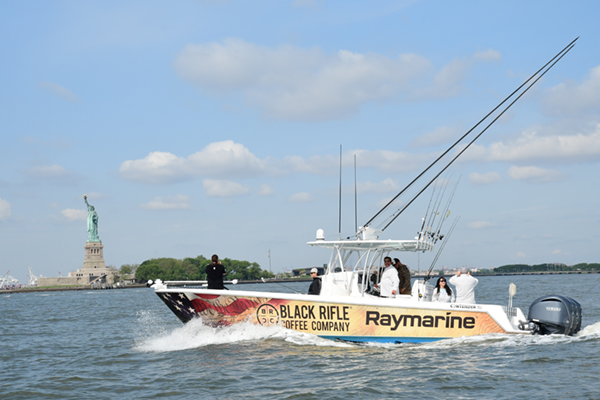
Frank is a firm believer in using only the most accurate and up-to-date charts in his plotter. He relies on Navionics® and frequently updates the software including the user data that is uploaded to the system by other boaters in the area also running the software. It’s a community effort that helps him be aware of potential new obstructions and obstacles that can come and go.
“Ferry traffic is constant throughout the day and well into the evening hours,” he continued. “The famous orange Staten Island Ferry is actually a fleet of big orange ferries, two of which transit the harbor every half hour, one inbound to Manhattan, the other outbound back to Staten Island. That adds up to almost 100 trips a day through the heart of the harbor each one throwing a serious wake in the process as other boat traffic scrambles to stay out of the way. The proliferation of “fast ferries” that sail from locations in New Jersey and on Long Island making runs to dockages all around Manhattan is almost incomprehensible. The fast ferries are catamarans, some almost 150 feet long and capable of carrying over 500 people, and they travel at speeds well over 30-knots. With so much ferry traffic I strongly recommend recreational boaters take the time to learn the ferry lanes, the types of ferry they will encounter in those lanes, and the daily time schedule. It is important to note that ferries do not move to avoid recreational traffic, it’s up to you to stay out of their way. And large ships always have the right of way and with good reason.”
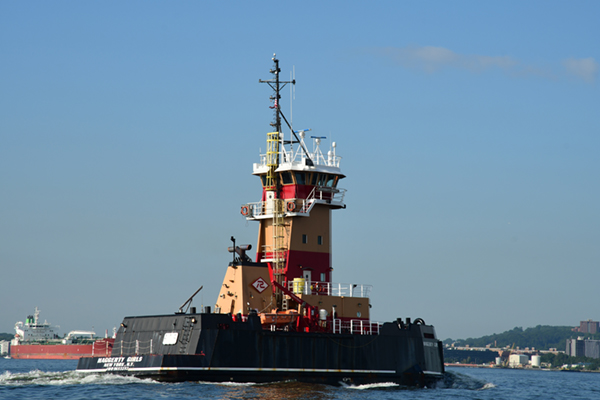
Large vessels like ships and oversized barges that are typically pushed by special tugboats have limited forward visibility. The closer you are to the bow of one of these monsters the less chance the helmsman operating it can see your boat because the bow and freight on deck literally blocks his vision. And even if they can see your boat, these vessels are simply incapable of stopping or turning to avoid you even at the slowest harbor speeds. A typical freighter or tanker can take well over a mile to come to a full stop from just 10 knots. Forget about the Post Panamax Super container ships that have containers stacked 80-feet high on the top deck which is already 50 feet above the water line. These behemoths can have a loaded weight in excess of 100,000 tons and require four super-tugs to bring them into port. For all these reasons, it is always your responsibility as the operator of a recreational vessel to stay out of the way of approaching ships, workboats and barges that are underway, yet we have seen people fishing from small boats in the main shipping channels who wait until the very last moment to move from the path of an approaching ship. That’s very dangerous.
“A similar scenario comes into play with large vessel radar systems,” Crescitelli said. Frank is a marine electronics specialist who has field tested and instructed others for Raymarine® for many years and he has worked with the New York Police and Fire Harbor Rescue teams on fine tuning the systems on their boats. “When a ship or oversized barge is approaching there is a point where your vessel will no longer fall under the radar beam because it is blocked by the bow of the vessel. You do not want to be in that place under any circumstances. If a large vessel strikes a recreational boat chances are the captain won’t even feel the impact, let alone see it from the bridge.”
Today’s recreational boats have sophisticated electronics, especially boats used in saltwater, yet many operators are not particularly familiar with all their capabilities. Radar can be a life saver but only if you use it enough to gain an innate understanding of what you are looking at on the screen when you can’t see like at night or in fog. Frank recommends operators run their radar when visibility is excellent so they can see what targets on the screen represent. Then you’ll know what it is when all you have to go by are the reflections on the radar screen. In a port area navigational markers can look small on screen but be large enough to sink a boat if you hit it at speed.
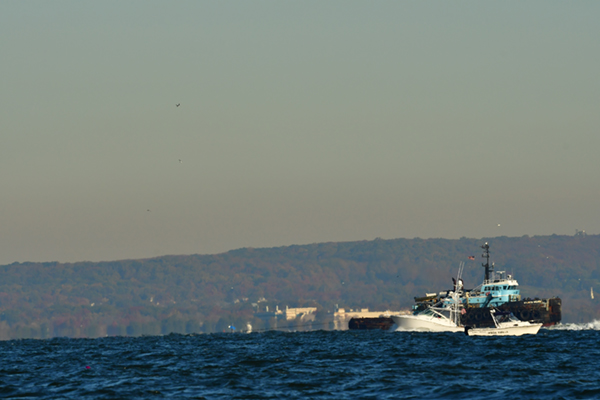
Recreational boats should take special care operating around tugboats and other large displacement hull ferries and workboats because even at modest speeds they can throw a disproportionately large wake. If you get caught between the wakes from two large vessels, the combined wakes will throw you and your passengers around like ragdolls and in the extreme could swamp your craft. For that reason, your boat should be carefully loaded, and occupants should remain wary of passing vessels and be near a secure handhold because you can be rocked, sometimes violently. Wearing a PFD at all times is a great precautionary practice.
“Areas around major cities and harbors require extra vigilance because floating debris can pop up when you least expect it,” Crescitelli says. “Port areas like New York and Newark, both part of the same complex, have been in operation for hundreds of years with areas of old, rotting docks, pilings and even discarded barges left along some side channels. Wood can dislodge from them and drift into channels. Items can fall off commercial vessels without anyone knowing it. Recently we avoided a collision with what turned out to be a metal propane tank that had been hit by at least one other boats before we removed it from the water and properly discarded it back on land. Boaters should be particularly careful around Moon tides when water rises higher than a normal high tide because flotsam that was high and dry can become inundated and float into the waterway. While this is not as big a problem as it was 20 or 30 years ago, I still manage to encounter old sections of pilings or decking from docks a few times a year that could do major damage to a hull or outboard motor if struck at speed.”
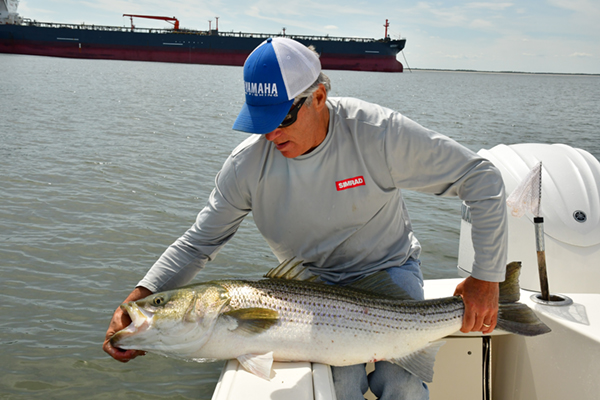
Even with all these things going on, sightseeing by boat in city harbors is truly fascinating and even more surprising, the fishing can be incredibly good. The Hudson River is a major spawning and nursery area for Atlantic striped bass, one of the most popular gamefish on the East Coast and you can even catch them in the harbor with all the boat traffic. Fishing in other metropolitan areas can be equally good. Government Cut, the main thoroughfare into Port Miami, is famous for its tarpon fishing, and the ocean entrance to the St. Johns River at Jacksonville, Florida provides great fishing for redfish and sea trout. You might even see a nuclear submarine while fishing there since Mayport Naval Station is one of the centers for submarine activity in the Atlantic. Operating a recreational boat in an urban port environment boasts amazing sights, sounds and fishing but navigating such waterways requires the operator and passengers to be ever vigilant and situationally aware. Harbors are not like a quiet weekend cruise on a calm lake or back bay. Extra care should be taken to make your time on these waters less stressful.
Back to Blue Life
Boating means different things to different people, but tens of thousands of boat owners live and boat in congested waterways that require a heightened level of awareness. If you boat in one of our country’s metropolitan regions, many of which are also busy commercial ports, you are navigating in an environment where you will be in close contact with vessels that operate under a different set of rules. In some ports, you will even find yourself in the company of ships so big they make your boat look like a barnacle on the back of a whale.

One Yamaha owner told us that after three decades of fishing out of an inlet where commercial vessel traffic was almost nonexistent, he moved to a new locale adjacent to New York Harbor and Port Newark. His former berth at a marina located on a small tidal river had easy access to the ocean through an inlet that was only challenging under severe weather conditions. Its inlet and river host a fair amount of recreational boat traffic and the occasional commercial fishing trawler or clammer headed to the unloading dock at a modest commercial fishing center adjacent to the inlet.
The move placed him in one of the busiest commercial ports in the world where scores of massive tankers, freighters, and container ships, some as large as the nearby skyscrapers, plied the waterways on a daily basis. Ferries, some that plod along throwing massive wakes and others that rush to their destinations at 30-plus knots, feed a daily stream of commuters to and from the city. There is a veritable flotilla of tour and dinner cruise boats navigating the waters around the sprawling harbor complex in addition to tugboats, barges and workboats, some that literally defy description. This parade of commercial vessels goes on day in and day out, and mixed in with it are recreational boats both large and small. It didn’t take long to realize that he, like Dorothy in Oz, wasn’t in Kansas anymore. This was big time boating in an environment rife with potential dangers that he never encountered before. Similar navigational challenges can be found in metropolitan harbors with commercial ports around the nation, places like Norfolk, Virginia, Miami and Jacksonville, Florida, New Orleans, Louisiana, Houston, Texas, Los Angeles, California and even Chicago, Illinois, one of many busy ports on the Great Lakes.

For some wisdom on boating and fishing in and around a major port we spoke with Yamaha pro captain Frank Crescitelli who grew up on Staten Island on the banks of New York Harbor and Raritan Bay. Frank has run boats in these congested waters for almost 50 years, the last 25 as a professional charter fishing captain. His boating experience started at a young age when he acquired a vintage 17-foot Fleetwood lapstrake wood skiff built on Staten Island and then progressed through a series of larger and faster outboard powered boats that included brands like Aquasport®, Regulator and Contender. He currently has two boats, a 2023 Contender 35 ST powered by triple Yamaha F300 outboards and a Blue Wave 24’ Pure Bay propelled by a single Yamaha F300.
“To be perfectly clear, New York Harbor and the surroundings bays and approaches present almost every commercial vessel situation you can imagine, and some that are so bazar as to be beyond imagining until you encounter them. And any number of them can be happening at almost the same time,” Crescitelli says. “There are tugs escorting ships, pushing and pulling barges, some of which are as large as ships. There are special anchorage areas with moorings to accommodate barges not in use and holding areas for large ships to drop anchor while awaiting their turn to enter the harbors to load or offload cargo. Another anchorage area is specifically for large tanker vessels that have their cargo of petrochemicals offloaded onto special barges to keep them away from other ships. And the number of cruise ships that depart and return to the harbor has increased exponentially in recent years. Operating a recreational vessel in such heavy commercial traffic can be tricky during daylight hours and at night it can be treacherous. New moorings pop up as needed and some are barely visible when a vessel or barge is not tied off to it. Whenever I see something new I mark it on my chart plotter, but I tend to avoid special anchorage areas unless the stripers are holding there, and they do at various times of the year.”

Frank is a firm believer in using only the most accurate and up-to-date charts in his plotter. He relies on Navionics® and frequently updates the software including the user data that is uploaded to the system by other boaters in the area also running the software. It’s a community effort that helps him be aware of potential new obstructions and obstacles that can come and go.
“Ferry traffic is constant throughout the day and well into the evening hours,” he continued. “The famous orange Staten Island Ferry is actually a fleet of big orange ferries, two of which transit the harbor every half hour, one inbound to Manhattan, the other outbound back to Staten Island. That adds up to almost 100 trips a day through the heart of the harbor each one throwing a serious wake in the process as other boat traffic scrambles to stay out of the way. The proliferation of “fast ferries” that sail from locations in New Jersey and on Long Island making runs to dockages all around Manhattan is almost incomprehensible. The fast ferries are catamarans, some almost 150 feet long and capable of carrying over 500 people, and they travel at speeds well over 30-knots. With so much ferry traffic I strongly recommend recreational boaters take the time to learn the ferry lanes, the types of ferry they will encounter in those lanes, and the daily time schedule. It is important to note that ferries do not move to avoid recreational traffic, it’s up to you to stay out of their way. And large ships always have the right of way and with good reason.”

Large vessels like ships and oversized barges that are typically pushed by special tugboats have limited forward visibility. The closer you are to the bow of one of these monsters the less chance the helmsman operating it can see your boat because the bow and freight on deck literally blocks his vision. And even if they can see your boat, these vessels are simply incapable of stopping or turning to avoid you even at the slowest harbor speeds. A typical freighter or tanker can take well over a mile to come to a full stop from just 10 knots. Forget about the Post Panamax Super container ships that have containers stacked 80-feet high on the top deck which is already 50 feet above the water line. These behemoths can have a loaded weight in excess of 100,000 tons and require four super-tugs to bring them into port. For all these reasons, it is always your responsibility as the operator of a recreational vessel to stay out of the way of approaching ships, workboats and barges that are underway, yet we have seen people fishing from small boats in the main shipping channels who wait until the very last moment to move from the path of an approaching ship. That’s very dangerous.
“A similar scenario comes into play with large vessel radar systems,” Crescitelli said. Frank is a marine electronics specialist who has field tested and instructed others for Raymarine® for many years and he has worked with the New York Police and Fire Harbor Rescue teams on fine tuning the systems on their boats. “When a ship or oversized barge is approaching there is a point where your vessel will no longer fall under the radar beam because it is blocked by the bow of the vessel. You do not want to be in that place under any circumstances. If a large vessel strikes a recreational boat chances are the captain won’t even feel the impact, let alone see it from the bridge.”
Today’s recreational boats have sophisticated electronics, especially boats used in saltwater, yet many operators are not particularly familiar with all their capabilities. Radar can be a life saver but only if you use it enough to gain an innate understanding of what you are looking at on the screen when you can’t see like at night or in fog. Frank recommends operators run their radar when visibility is excellent so they can see what targets on the screen represent. Then you’ll know what it is when all you have to go by are the reflections on the radar screen. In a port area navigational markers can look small on screen but be large enough to sink a boat if you hit it at speed.

Recreational boats should take special care operating around tugboats and other large displacement hull ferries and workboats because even at modest speeds they can throw a disproportionately large wake. If you get caught between the wakes from two large vessels, the combined wakes will throw you and your passengers around like ragdolls and in the extreme could swamp your craft. For that reason, your boat should be carefully loaded, and occupants should remain wary of passing vessels and be near a secure handhold because you can be rocked, sometimes violently. Wearing a PFD at all times is a great precautionary practice.
“Areas around major cities and harbors require extra vigilance because floating debris can pop up when you least expect it,” Crescitelli says. “Port areas like New York and Newark, both part of the same complex, have been in operation for hundreds of years with areas of old, rotting docks, pilings and even discarded barges left along some side channels. Wood can dislodge from them and drift into channels. Items can fall off commercial vessels without anyone knowing it. Recently we avoided a collision with what turned out to be a metal propane tank that had been hit by at least one other boats before we removed it from the water and properly discarded it back on land. Boaters should be particularly careful around Moon tides when water rises higher than a normal high tide because flotsam that was high and dry can become inundated and float into the waterway. While this is not as big a problem as it was 20 or 30 years ago, I still manage to encounter old sections of pilings or decking from docks a few times a year that could do major damage to a hull or outboard motor if struck at speed.”

Even with all these things going on, sightseeing by boat in city harbors is truly fascinating and even more surprising, the fishing can be incredibly good. The Hudson River is a major spawning and nursery area for Atlantic striped bass, one of the most popular gamefish on the East Coast and you can even catch them in the harbor with all the boat traffic. Fishing in other metropolitan areas can be equally good. Government Cut, the main thoroughfare into Port Miami, is famous for its tarpon fishing, and the ocean entrance to the St. Johns River at Jacksonville, Florida provides great fishing for redfish and sea trout. You might even see a nuclear submarine while fishing there since Mayport Naval Station is one of the centers for submarine activity in the Atlantic. Operating a recreational boat in an urban port environment boasts amazing sights, sounds and fishing but navigating such waterways requires the operator and passengers to be ever vigilant and situationally aware. Harbors are not like a quiet weekend cruise on a calm lake or back bay. Extra care should be taken to make your time on these waters less stressful.
Back to Blue Life
